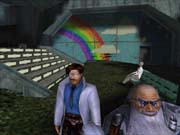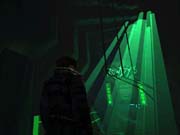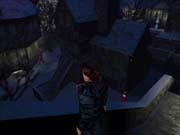Japanese role-playing games are a staple of console gaming. But aside from some lackluster ports, they've been almost nonexistent on the PC. Developer Ion Storm is attempting to redress this imbalance with Anachronox, a Final Fantasy-inspired game designed specifically for the PC. It manages to stay true to its console roots while modifying the formula in a few key areas, not the least of which is the addition of plot and dialogue not translated from Japanese. Though these changes are too subtle to bridge the gap between people who enjoy this type of linear adventure-RPG hybrid and those who don't, Anachronox is a solid addition to the genre and makes up for some rough spots with a welcome sense of humor and a lot of personality.

However, there is one major caveat: The game gets off to a slow start. Though the convention in this genre is to keep you on rails for a while before opening up, Anachronox is a little ridiculous in this respect. The first five or six hours involve lots and lots of running mindless errands without much in the way of combat, puzzle solving, or anything else that could be considered good gameplay to break up the monotony. You'll generally be asked to walk somewhere, get something, or talk to somebody, and walk back. In most cases, this involves two or three transitions between areas. Worse yet, in between the loading times from area to area, you'll have to ride on elevators, which means watching an unavoidable animation of you riding the elevator--a tactic seemingly designed for no other purpose than to annoy you. The whole thing is like watching a five-hour cutscene powered by you tapping the left mouse button.
The beginning part introduces you to the main character, Sylvester "Sly" Boots, a down-on-his-luck private detective living in a futuristic city built on a mysterious, giant alien artifact. As usual with private detectives, he owes money all over town to the wrong kinds of people. His attempt to get a job and pay back his debts eventually leads him off of Anachronox on a quest to save the universe. Though it all sounds pretty standard, there's a lot of cleverness in the dialogue and plot details. Anachronox joins the short list of games such as Giants: Citizen Kabuto and Grim Fandango that manage to successfully convey an actual sense of humor--not "funny for a game" funny, but legitimately funny.
This humor helps mitigate the uneventful first five hours of gameplay. But the best way to get through it is simply to keep reminding yourself that it's going to get better, because the following 25 hours really do pick up; the fighting becomes more varied, more complex, and more frequent, and both the strict linearity and the traditional errand puzzles become better disguised.

The combat system lies somewhere between the high watermark set by the Grandia series and the relative simplicity of something like the one used in Skies of Arcadia. Fights occur in real time with each character requiring a varying recovery period between each combat action. The biggest tactical addition to the system is the inclusion of movement. Characters can move between set points on a grid overlaid across the battlefield. This allows for a real difference between melee and ranged weaponry, as characters armed only with close-in weapons must maneuver themselves next to opponents, and from this position they may block the line of sight of characters farther away. Though it's a simple feature, it helps break the attack-heal routine inherent in a lot of fighting systems in these sorts of games.
One odd omission is the inability to skip a character's turn while in battle. When it's their turn to act, characters have to do something before play can continue. This means that characters out of range of an enemy must either move into range or use an item or special attack instead of simply being able to sit back and wait. It's not a huge flaw, but it's a consistently annoying one.

Though each of the game's seven characters (who become available as the plot progresses, though you can have only three in your party at a time) has a series of unique special attacks that border on magical, about a quarter of the way through the game the mystech concept is introduced, which forms Anachronox's magic system proper. Mystechs are chunks of rock that are imbued with various powers such as the ability to shoot futuristic forms of fireballs and ice storms.
At roughly the game's halfway point, an ancillary component of mystech is introduced. Called the elementor system, it's an absurdly complex way to modify mystech, in the tradition of Final Fantasy VII's materia system. By socketing various colored bugs into your mystech and then leveling them up, you can create a huge variety of different effects. While mastery--or even a basic understanding--of elementors is not strictly necessary to complete the game, it adds another layer of depth to the combat system and should keep FAQ writers busy for months.
Perhaps the best change the developer has made to the Japanese RPG formula is the elimination of the thousands of random battles traditional to the genre. Each area features a set number of encounters, though you can often navigate them extra times for added experience. One thing to note about combat is that on "normal" difficulty, it's too easy--especially once you start to get area-effect mystechs. Anyone wanting a challenge should play on "hard."
The sound is good as well, especially the voice acting. It's a testament to the quality of the voice work that during the scenes in which the dialogue is merely presented through text boxes, you'll wish it were spoken.

Though it uses id Software's 4-year-old Quake II engine, Anachronox still looks pretty good. Environments and especially characters are somewhat blocky, but the level design and character design are of high-enough quality that you won't notice the relative lack of polygons for long. The ability to render facial animations has also been implemented, which permits the characters to display a lot of personality. Most of the environments, especially the city of Anachronox itself, are filled with little details that really bring the game to life. Ironically, the early boring parts of the game tend to have a more interesting look than the later levels, too many of which take place in nondescript areas such as alien tunnels and a sort of generic, Tomb Raider-esque ancient stone city. Luckily, by that point the gameplay itself should hold your attention.
Anachronox is generally stable, and a patch has already been released addressing most of its technical issues. However, Windows 2000 is not officially supported, and some serious problems have been reported getting the game to run under that OS. Windows 2000 users may wish to try the downloadable demo to ensure compatibility.
If you have the patience to make it through the slow start, Anachronox will reward you with great dialogue, great voice acting, and an increasingly complex fighting system. In terms of gameplay, it's a by-the-book entry in an established genre, but its American perspective and a successful sense of humor set it apart from the pack.